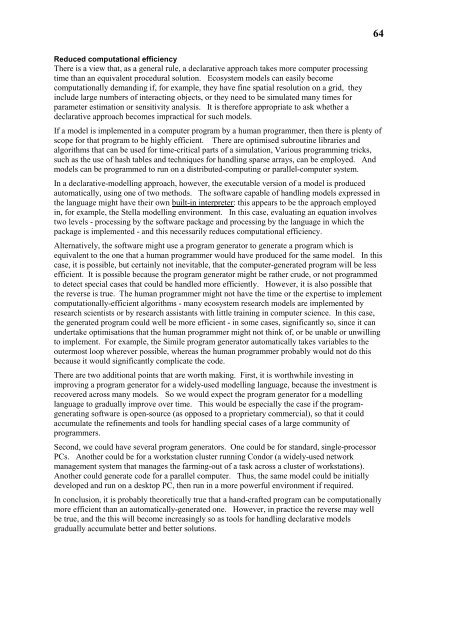pdf: 600KB - Potsdam Institute for Climate Impact Research
pdf: 600KB - Potsdam Institute for Climate Impact Research
pdf: 600KB - Potsdam Institute for Climate Impact Research
You also want an ePaper? Increase the reach of your titles
YUMPU automatically turns print PDFs into web optimized ePapers that Google loves.
64<br />
Reduced computational efficiency<br />
There is a view that, as a general rule, a declarative approach takes more computer processing<br />
time than an equivalent procedural solution. Ecosystem models can easily become<br />
computationally demanding if, <strong>for</strong> example, they have fine spatial resolution on a grid, they<br />
include large numbers of interacting objects, or they need to be simulated many times <strong>for</strong><br />
parameter estimation or sensitivity analysis. It is there<strong>for</strong>e appropriate to ask whether a<br />
declarative approach becomes impractical <strong>for</strong> such models.<br />
If a model is implemented in a computer program by a human programmer, then there is plenty of<br />
scope <strong>for</strong> that program to be highly efficient. There are optimised subroutine libraries and<br />
algorithms that can be used <strong>for</strong> time-critical parts of a simulation, Various programming tricks,<br />
such as the use of hash tables and techniques <strong>for</strong> handling sparse arrays, can be employed. And<br />
models can be programmed to run on a distributed-computing or parallel-computer system.<br />
In a declarative-modelling approach, however, the executable version of a model is produced<br />
automatically, using one of two methods. The software capable of handling models expressed in<br />
the language might have their own built-in interpreter: this appears to be the approach employed<br />
in, <strong>for</strong> example, the Stella modelling environment. In this case, evaluating an equation involves<br />
two levels - processing by the software package and processing by the language in which the<br />
package is implemented - and this necessarily reduces computational efficiency.<br />
Alternatively, the software might use a program generator to generate a program which is<br />
equivalent to the one that a human programmer would have produced <strong>for</strong> the same model. In this<br />
case, it is possible, but certainly not inevitable, that the computer-generated program will be less<br />
efficient. It is possible because the program generator might be rather crude, or not programmed<br />
to detect special cases that could be handled more efficiently. However, it is also possible that<br />
the reverse is true. The human programmer might not have the time or the expertise to implement<br />
computationally-efficient algorithms - many ecosystem research models are implemented by<br />
research scientists or by research assistants with little training in computer science. In this case,<br />
the generated program could well be more efficient - in some cases, significantly so, since it can<br />
undertake optimisations that the human programmer might not think of, or be unable or unwilling<br />
to implement. For example, the Simile program generator automatically takes variables to the<br />
outermost loop wherever possible, whereas the human programmer probably would not do this<br />
because it would significantly complicate the code.<br />
There are two additional points that are worth making. First, it is worthwhile investing in<br />
improving a program generator <strong>for</strong> a widely-used modelling language, because the investment is<br />
recovered across many models. So we would expect the program generator <strong>for</strong> a modelling<br />
language to gradually improve over time. This would be especially the case if the programgenerating<br />
software is open-source (as opposed to a proprietary commercial), so that it could<br />
accumulate the refinements and tools <strong>for</strong> handling special cases of a large community of<br />
programmers.<br />
Second, we could have several program generators. One could be <strong>for</strong> standard, single-processor<br />
PCs. Another could be <strong>for</strong> a workstation cluster running Condor (a widely-used network<br />
management system that manages the farming-out of a task across a cluster of workstations).<br />
Another could generate code <strong>for</strong> a parallel computer. Thus, the same model could be initially<br />
developed and run on a desktop PC, then run in a more powerful environment if required.<br />
In conclusion, it is probably theoretically true that a hand-crafted program can be computationally<br />
more efficient than an automatically-generated one. However, in practice the reverse may well<br />
be true, and the this will become increasingly so as tools <strong>for</strong> handling declarative models<br />
gradually accumulate better and better solutions.
















